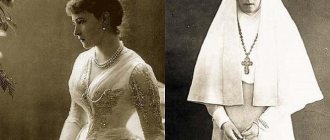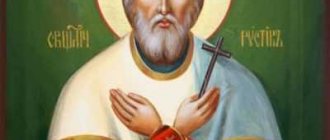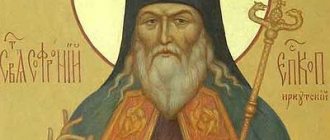Life of Saint Agafya
Saint Agathia is a Christian martyr who lived in the 3rd century in one of the cities located in Sicily - Catania. The girl was born into a rich and noble family, but from an early age her jewelry was not gold and silver items, but virtuous deeds and sincere faith in Jesus Christ. In addition to her flexible and God-fearing character, the girl was distinguished by her unprecedented beauty, so many suitors from noble families of Sicily wooed her. However, Agafya wanted to maintain her chastity and devote her life to the Heavenly Bridegroom.
One of those who wanted to marry the girl was the prefect of Sicily, whose name was Quitian. However, at that time the future saint had already accepted baptism and refused it. In 250, the Roman governor Decius issued a special decree according to which all Christians were persecuted for their faith. They had two options - to worship the pagan gods and make sacrifices to them and renounce Christ forever, or remain faithful to the One God, but then terrible torment and death awaited them.
Taking advantage of this situation, Kvitsian tried to persuade Agafya to have a sinful relationship and cohabitation in exchange for saving her life. In addition, after the death of her parents, the girl received a rich inheritance, which the official also sought to take possession of.
Despite the fact that if she refused, terrible torment awaited the girl, she did not agree to sinful cohabitation and wanted to remain faithful to the Lord. Rejecting the prefect's advances, she fervently prayed to Jesus to strengthen her physically and spiritually and allow her to endure all the trials that lay ahead.
To break the girl’s will, Kvitsian sent her for a whole month to the house of a dissolute woman named Aphrodisia, so that she could influence the rebellious Christian and convince her to accept the prefect’s offer. However, after the specified time had passed, Aphrodisia answered the Roman official that she was unable to break the will of the young Christian woman and convince her to agree to the prefect’s proposal.
Realizing that he would not be able to achieve his goal through persuasion, Kvitsian initiated a lawsuit against Agafya in order to legally take possession of the girl’s inheritance and sentence her to death. At the trial, he began to ask the Christian woman how a girl from a noble family could stoop to the point of confessing someone else’s God. To which Agafya replied that Jesus, who during his life was everyone’s servant, is the only one worthy of praise and worship.
Then the official ordered the girl to make a sacrifice to the pagan gods, and the Christian replied that he himself was ashamed of his gods, then why was he inviting her to glorify them. Angry that he could not break Agafya’s will, he gave the order that the girl be scourged and her body burned with a hot iron, but when the Christian woman bravely endured the torment and did not renounce her faith, he personally cut off her nipples. After this, they threw the holy martyr into prison, hoping that she would die there. However, the Lord, seeing the girl’s faithfulness, sent his apostle Peter to her, who appeared accompanied by an angel carrying a torch. The apostle healed the wounds of the Christian woman, and the cell where the girl was was shone with such a bright light that all the guards fled in fear.
Agafya could take advantage of the current situation and escape from the dungeon, but she did not want the guards to be punished because of her. In addition, the girl dreamed of receiving the crown of martyrdom, which was already close. So she prayed fervently to the Lord and remained where she was. The next morning the girl was again brought to the Roman official, and he again ordered her to worship the pagan gods and make sacrifices to them. However, the Christian woman again refused him and asked how, seeing the healing of her wounds, he could again force her to renounce her faith in the One God.
The prefect became furious and ordered the fire to be lit and the stubborn Christian woman thrown onto hot coals. However, as soon as the guards carried out his command, a strong earthquake immediately began. This time, even the residents called on the official to stop torturing the girl, as they feared for their lives. The tormentors extinguished the fire, but by that time Saint Agafya had already departed to the Lord. The life states that she was only 16 years old at that time.
After the death of the holy martyr, the Etna volcano woke up, the Christian community of Catania offered prayers to Agathia, and the lava did not reach the city, stopping outside its borders.
Having learned about this miracle, many townspeople accepted Christ as the only God and renounced the worship of pagan idols.
Traditions and customs on February 18: history and signs on the day of St. Agafya
In the folk calendar, February 18 is called the day of Agafya the Cow, also called Famine. Orthodox Christians honor the memory of the holy martyr Agafya. The history of the holiday, customs, what can and cannot be done on this day - in the material of "People's News".
wikipedia.org / Public domain
Story
Agafya lived in the 3rd century, was born in Sicily. According to legend, she was granted extraordinary beauty. Taking the path of faith, she only strengthened it. During the reign of Emperor Decius, persecution of Christians began and Agafya was captured. Decius, seeing how beautiful she was, wanted her to be his wife, but was refused. No tricks helped - Agafya refused the wedding, despite threats of deprivation. She was thrown into prison and tortured. Afterwards, the Apostle Peter appeared to her, healing her wounds. Agafya prayed to the Lord and gave her soul.
pixabay.com/
Customs
The ancients feared a malicious creature called cow death. It was believed that she appeared to people in the form of a black cat, dog or ugly old woman. To protect themselves from its influence, women performed the plowing ritual; men were forbidden to leave the house during the ceremony. Also, thistles were laid out at gates and thresholds, and houses and barns were fumigated with them.
pixabay.com/
What not to do
Animals should be treated with respect. Livestock cannot be left unattended - everyone needs to be fed, watered, and shown your care and love.
A cow must not be offended or beaten, otherwise her milk may disappear forever. Dogs were traditionally kept on a leash - it was believed that cow death could enter them.
Rude treatment of those in need is also prohibited; requests for help should not be refused. Otherwise, you can become one yourself.
Single girls and boys should not cut their hair so as not to scare away love.
It was believed that you could bring evil spirits upon yourself if you looked out the window after sunset - it would take away your beauty and bring disaster.
Federal News Agency / Stepan Yatsko
What can you do
In order to protect domestic animals, it was believed that the house should be cleaned in old bast shoes, which had been soaked in tar in advance.
As a tribute to Saint Agathia, bread was blessed - this way one can create protection from fire.
It is imperative to honor the memory of our ancestors, to let them know that they are not forgotten.
The ancients believed that a dream on the night of February 18 could be prophetic. But in order for everything to go as it should, you can’t tell anyone about it.
pixabay.com/
Signs
— Warm day — the warm weather will continue for a long time, there will be no more severe frosts.
- Frost - warm spring and hot summer.
- It snows in frosty weather - warming will come soon.
- Frosty weather without snow - drought is expected in summer.
Subscribe to us on social networks ✅ VKontakte ✅ Odnoklassniki ✅ Telegram ✅ Yandex.Zen
Texts of prayers
You can turn to Saint Agafya for help using the following texts of prayers. They are recommended to be read before the image of the martyr.
Troparion
Thy lamb, Jesus, Agathia,/ calls with a great voice:/ I love Thee, my Bridegroom,/ and I suffer for Thy seeking,/ and I crucify myself and bury myself in Thy Baptism,/ and I suffer for Thy sake. , for I reign in You, / and I die for You, yes, and I live with You,/ but as an immaculate sacrifice, accept me, sacrificed to You with love.// Through your prayers, for You are merciful, save our souls.
Translation: Your Lamb, Jesus, Agathia, cries out loudly: “I love You, my Bridegroom, and seeking You, I suffer, and I am crucified, and I am buried with You in Your baptism, and I endure torment for You, that I may reign in You, and die for You, so that I may live with You; but accept me as an immaculate sacrifice, offered to You with love!” Through her intercessions, as the Merciful One, save our souls.
Church Orthodox holidays February 18
Today, February 18, the church also honors Orthodox saints, this is a day of remembrance:
Saint Theodosius of Chernigov
The memory of Archbishop Feodosius of Chernigov is honored. The monk was born in the 17th century. He received the rank of archbishop thanks to the intercession of the teacher Lazarus, who saw in him a gift of God. He founded the Assumption Monastery, the Church of the Nativity of the Virgin Mary, and the Lyubetsk monastery. He died in 1696, and 200 years later he was canonized. After death, numerous healings were recorded through prayers to St. Theodosius, and even in 1942, in besieged Leningrad, as soon as the relics of Theodosius were transferred from the museum to the temple, Ladoga froze, opening the Road of Life.
Holy Martyr Agathia (Panorma) - patroness of Sicily
“May the Church be adorned today with glorious purple, dipped in the pure blood of Agathia the Martyr // Rejoice, crying out, Catanian praise.”
Kontakion to the Martyr Agathia of Panorma (Palermo), tone 4
On February 18 (5), the Orthodox Church honors the memory of the holy martyr Agathia of Panorma (Palermo), a Sicilian virgin, who suffered under the emperor Decius in the year 251 among the early Christian martyrs; she is revered equally in the Eastern and Western churches.
Saint Agathia came from a noble and wealthy family in the city of Catania in Sicily. There, in Sicily, she suffered for her faith in Christ, so most of all she is revered and loved by the inhabitants of the island of Sicily, calling Saint Agathia their patroness.
Striving from a very young age to devote herself entirely to the Lord, Agathia also shone in the virtue of virginity. This virtue was especially glorified in a special essay by Saint Methodius, Bishop of Tire (“The Feast of the Ten Virgins”), written in the second half of the 3rd century: “If my mouth, as one of the virgins says about this, I will open to explain the Scriptures, or in order to sing praises to God in an Orthodox and decent manner, and I will put a door and a guard on my lips, so as not to speak vain things: then my lips are pure and dedicated to God. If I block my ears from slander and reproach and open them to the Word of God: then I have dedicated my ears to the Lord... If I am pure in heart, I devote all my thoughts to the Lord, I do not think about anything vain, pride and anger do not live in it, I think about the law of the Lord day and night: then verily I make a great vow, that I may be cleansed with purity” (Num. 6:2).
During the period of persecution of Christians under Emperor Decius (Decius) in 251, Agathia, being a fifteen-year-old girl, was captured by order of the prefect Quintian for refusing to sacrifice to idols, and was brought before his court. Seduced by Agathia's beauty and wealth, he wanted to marry her and began to look for a way to persuade the girl to marry. To do this, he entrusted her to the pagan woman Aphrodisia, who was notorious. However, life in a pagan house, amidst fun and luxury, did not in any way endear him to Saint Agathia. The admonitions of the pagan widow also did not help. Aphrodisia sincerely admitted her defeat, assuring that it was easier to change the nature of iron or stone than to break Agathia’s determination. After this, the prefect summoned the Christian woman to his place and asked about her origin. “If you are one of the nobles, then why are you acting like a slave?” “Because I am a servant of Christ,” answered Agathia, “and every servant of Christ is truly freer than any creation, for by His grace he gains power over himself.” When after this they began to force her to worship the pagan gods, she laughed at them. Quintian ordered her to be mercilessly beaten in the face and thrown into prison to await further torture.
The next day, during the second interrogation, when asked to perform a pagan sacrifice in order to save her life, the saint replied that our only salvation is in Christ, the Son of the Living God. Seeing this, the ruler decided to resort to more drastic measures. They began to scourge her cruelly. While her body was torn apart with red-hot hooks and the wounds were burned with torches, she exclaimed: “The torment You sent down is a great joy for me, because grain is not put into storage without being dispelled. It’s the same with my soul: it cannot achieve the glory of eternal bliss unless it is taken away from the body through torment.” When Agathia was in captivity, the Apostle Peter appeared to her and completely healed her wounds. At the same time, an extraordinary light illuminated the dungeon; The soldiers, frightened by this, fled. Saint Agathia, however, did not take advantage of this, humbly awaiting the crown of martyrdom.
On the fifth day, Quintian ordered Saint Agathia to be brought to him again and, not at all surprised by the miraculous recovery of the virgin, he ordered the naked martyr to be rolled over sharp shards and burning coals scattered on the ground. Suddenly an earthquake struck the entire area and part of the palace collapsed. The inhabitants of Catania rushed to the praetorium in horror and began to threaten the prefect that they would burn him along with the remains of the palace if he did not release the holy martyr - the culprit of God's retribution. The torture was stopped, after which Saint Agathia was again sent to prison, where, having fervently prayed to God and thanked Him for the strength and patience with which she endured the torment, she betrayed her soul to Him.
When the residents of the city found out about this, they hastened to arrange a funeral for the holy martyr, bringing with them myrrh and incense. According to legend, at the moment when they were laying the body of the martyr Agathia in the porphyry tomb, an Angel appeared in the form of a beautiful young man, accompanied by hundreds of children in white clothes. He placed a marble slab on the grave with the inscription: “Holy Devoted Soul. Honor to God. Defender of the Motherland." Then he disappeared.
The wrath of God soon struck the wicked tormentor Quintian. When he went to the homeland of St. Agathia, to the city of Palermo in order to take possession of her property, then during one crossing he fell into the water and drowned. The following year, on the day of the death of the holy martyr, Mount Etna began to erupt on the island of Sicily. The inhabitants of the island, taking the blanket lying on the grave, blocked it, like a shield, from the fiery river, which immediately stopped. This miracle was repeated more than once in subsequent centuries, which is why Saint Agathia is fervently prayed to as the protector of the city of Catania. This also served as the basis for faith in the help of the martyr Agathia against disasters from fire.
In the West, Saint Agathia is most often called Agatha. Saint Agathia (Agatha) is the patroness of the city of Catania and all of Sicily, as well as the state of Malta. The catacombs located in Malta in Rabat, a suburb of Mdina, are called the catacombs of St. Agatha, since, according to local legend, the saint was in Malta for some time, hiding from her pursuers. In the Republic of San Marino, the state award is the Order of Saint Agatha. But of course, the most revered place of St. Agatha on earth is the south of Italy, the city of Catania in Sicily.
It is believed that the temple stands on the site of the prison in which Saint Agathia languished before her torment, and where the Apostle Peter appeared to her and healed her wounds. This church of St. Agathia, “in the Dungeon,” is very loved by the inhabitants of Catania. In the same church there is a piece of lava, with imprints of the saint’s feet, and a 15th-century icon depicting Agathia. It is known that local Christians buried the holy martyr Agathia outside the city, and 60 years later they transferred her remains to the newly built cathedral in the city of Catania.
The life of this wondrous martyr teaches us to patiently and courageously endure all the suffering and hardships of life, and also to believe that suffering is sent by God for our own salvation.
Sources:
- https://days.pravoslavie.ru/Life/life6376.htm
- https://pravoslavie.ru/59535.html
- https://filaretuos.livejournal.com/101716.html
- https://azbyka.ru/days/sv-agafija-panormskaja-pale…
Agafya Golodukha: what can and is strictly forbidden to do on February 18
On February 18, 2022, the Orthodox day of remembrance of the holy martyr Agathia (Agatha) takes place, as well as the folk holiday Agafia the Cow, which is also called Famine. What actions are absolutely forbidden to do on this day, and what are recommended to do. The main traditions and beliefs for today. Folk signs that are valid 02/18/2022.
Nature:
- If the day turns out to be frosty, it will soon become warmer.
- Frost on February 18 is considered a harbinger of a dry summer.
- The colder it is on this day, the hotter and drier the summer will be.
- Expect drought in the warm season if there is not much snow falling before Agafya the Cowshed.
- It will soon become warmer if water rises in open reservoirs and wells.
- Prepare for snowfall if you notice that leather products have become soft.
- There will be no more severe frosts if it is warm and clear on this day.
- They believed that spring would be early and would soon become warmer if the forest in the distance seemed black
What can all Orthodox Christians do on February 18?
Among the people, Agafya was considered the protector and patroness of livestock, in particular cows. They were the most revered animals, because they were considered the main nurses for the peasants.
What you are allowed to do on February 18:
- It is customary to carry out various rituals and ceremonies at Agafya Korovnitsa to protect livestock from pestilence and the evil eye. To do this, the cows were given holy water to drink and fed with a slice of bread blessed in the church. They also soaked old bast shoes in tar and left them in the barn - their smell was supposed to scare away evil spirits.
- To protect against evil spirits, the house and barn were fumigated with smoke from a set of thistles on fire.
- Bouquets of thistles were always hung near the front door, chimneys and windows - it was believed that not a single evil spirit could penetrate this protection.
- At Agafya Korovnitsa you need to seal all the cracks with clay and close the pipes, otherwise demons can enter the house through them.
- The girls tried to remember the dream - according to legend, if you don’t tell anyone about it, it will definitely come true within 20 days.
People called Agafya not only the Cowgirl, but also the Memorial Lady. On February 18, it was customary to go to church and light candles for the repose, after which to arrange a funeral dinner and be sure to leave a plate and cutlery for the deceased family members.








